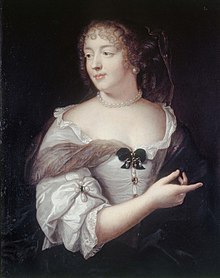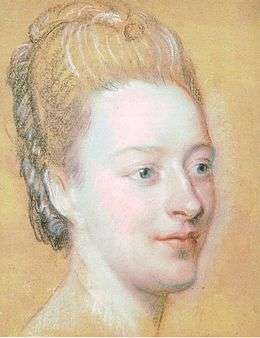Women letter writers
Women letter writers in early modern Europe created lengthy correspondences, where they expressed their intellect and their creativity; in the process, they also left a rich historic legacy.



Over time, a large number of women's correspondences have been made the subject of publications. Some among them ignored the literary value of these missives that were sometimes circulated by their recipients. Some correspondences were, on the other hand, strictly private and their literary value—and historic value, as well—was not revealed until the rediscovery of these letters, perhaps long after the death of their authors, as in the case of Élisabeth Bégon, whose correspondence was not discovered until 1932 in the archives of the French Ministry of the Navy.
It is usually agreed that what makes these letters distinctive emanates from their spontaneity. Marie de Sévigné was the incarnation of this quality, to the point of becoming considered by many as the archetype of the woman letter writer, and an altogether literary author, even among her contemporaries, such as Suzanne Curchod:
It is this precious collection that seems to flow into the reputation of all women: because it is always repeated, ever since Madame de Sévigné, that women write better than men and that they feel things more delicately than them. Suzanne Curchod
In 1669, the famous Letters of a Portuguese Nun appeared, presented as a translation of five letters sent by a Portuguese nun to a French officer. For a long time, these letters were accepted as authentic letters written by Mariana Alcoforado, before being definitively shown by a modern critic to be a work of literary fiction, attributed to Gabriel de Guilleragues.
The frontier between reality and fiction becomes blurry between literature and correspondence, above all when novelists turned this writing technique into a literary device that would become the epistolary novel, a genre that reached its peak during the Enlightenment when writers tried to persuade readers that between their hands was a real correspondence, which is what Jean-Jacques Rousseau more or less achieved with Julie, or the New Heloise.
Some famous women letter writers
- Juliette Adam
- Jeanne d'Albret
- Sophie Arnould
- Elizabeth Charlotte, Princess Palatine
- Louisa Dow Benton
- Louise Bénédicte de Bourbon
- Catherine de Bourbon
- Adélaïde de la Briche
- Cécile Bruyère
- Marie-Angélique de Coulanges
- Christine de Pisan
- Zulma Carraud
- Marquise de Caylus
- Isabelle de Charrière
- Anastasie de Circourt
- Mary Clarke
- Sophie Cottin
- Hélisenne de Crenne
- Suzanne Curchod
- Madeleine Des Roches
- Catherine Des Roches
- Marie Anne de Vichy-Chamrond, marquise du Deffand
- Louise d'Épinay
- Marie-Madeleine de La Fayette
- Marie-Thérèse Geoffrin
- Françoise de Graffigny
- Marie-Madeleine Hachard
- Anne-Catherine Helvétius
- Maria Theresa
- Sophie d'Houdetot
- Alix de Lamartine
- Ninon de Lenclos
- Amélie Lenormant
- Julie de Lespinasse
- Blandine Liszt
- Marie Anne de Mailly
- Françoise de Maintenon
- Sophie de Maraise
- Marguerite de Navarre
- Mary Montagu
- Matilda of Flanders
- Jeanne Marie Bouvier de La Mothe-Guyon
- Juliette Récamier
- Marie-Jeanne Riccoboni
- Manon Roland
- Gabrielle Roy
- Madeleine de Sablé
- Madame de Saint-Huberty
- George Sand
- Marie de Sévigné
- Marguerite de Launay, baronne de Staal
- Germaine de Staël
- Sophie Swetchine
- Claudine Guérin de Tencin
- Marie-Anne de La Trémoille
- Louise Élisabeth Vigée Le Brun
- Sophie Volland
References
- Lettres de femmes: textes inédits et oubliés du XVIe au XVIIIe", (éd.) Elisabeth C. Goldsmith and Colette H. Winn, Paris, H. Champion, 2005, 448 p. ISBN 2-7453-1123-9
- L’épistolaire au féminin : correspondances de femmes, XVIIIe au XXe, (éd.) Brigitte Diaz, Jürgen Siess, Caen, Presses universitaires de Caen, 2006 ISBN 2-84133-240-3
- Marie-France Silver, Marie-Laure Girou-Swiderski, Femmes en toutes lettres : les épistolières du XVIIIe", Oxford, Voltaire Foundation, 2000 ISBN 0-7294-0741-1
- Josée Chomel, Philippe Chomel, Michel Cabaud, Madame de Sévigné à Grignan, une épistolière en Provence, Lyon, Aubanel, 1996 ISBN 2-7006-0213-7
- Lionel Duisit, Madame Du Deffand, épistolière, Genève, Droz, 1963
- Daniel Des Brosses, La Palatine : l’incorrigible épistolière aux 60,000 lettres, Paris, France, 2004 ISBN 2-913451-20-9
- Rodolphe Trouilleux, N’oubliez pas Iphigénie : biographie de la cantatrice et épistolière Sophie Arnould, 1740-1802, Grenoble, Alzieu, 1999 ISBN 2-910717-00-3
- Sophie Marcotte, Gabrielle Roy épistolière, Ottawa, Bibliothèque nationale du Canada, 2003 ISBN 0-612-69903-X
- Catherine Blondeau, Julie de Lespinasse épistolière", 1761-1776, Lille, A.N.R.T, Université de Lille III, 1994
- Josette Chéry-Sobolewski, Madame Riccoboni épistolière, Paris, Université de Paris-Sorbonne, 1993
- Mireille Bossis, Charles. A. Porter, L’épistolarité à travers les siècles : geste de communication et/ou geste d’écriture, Stuttgart, Franz Steiner, 1987
See also
- Women's writing
- Nu shu
- Écriture féminine
- Epistolary novel
- Women's history